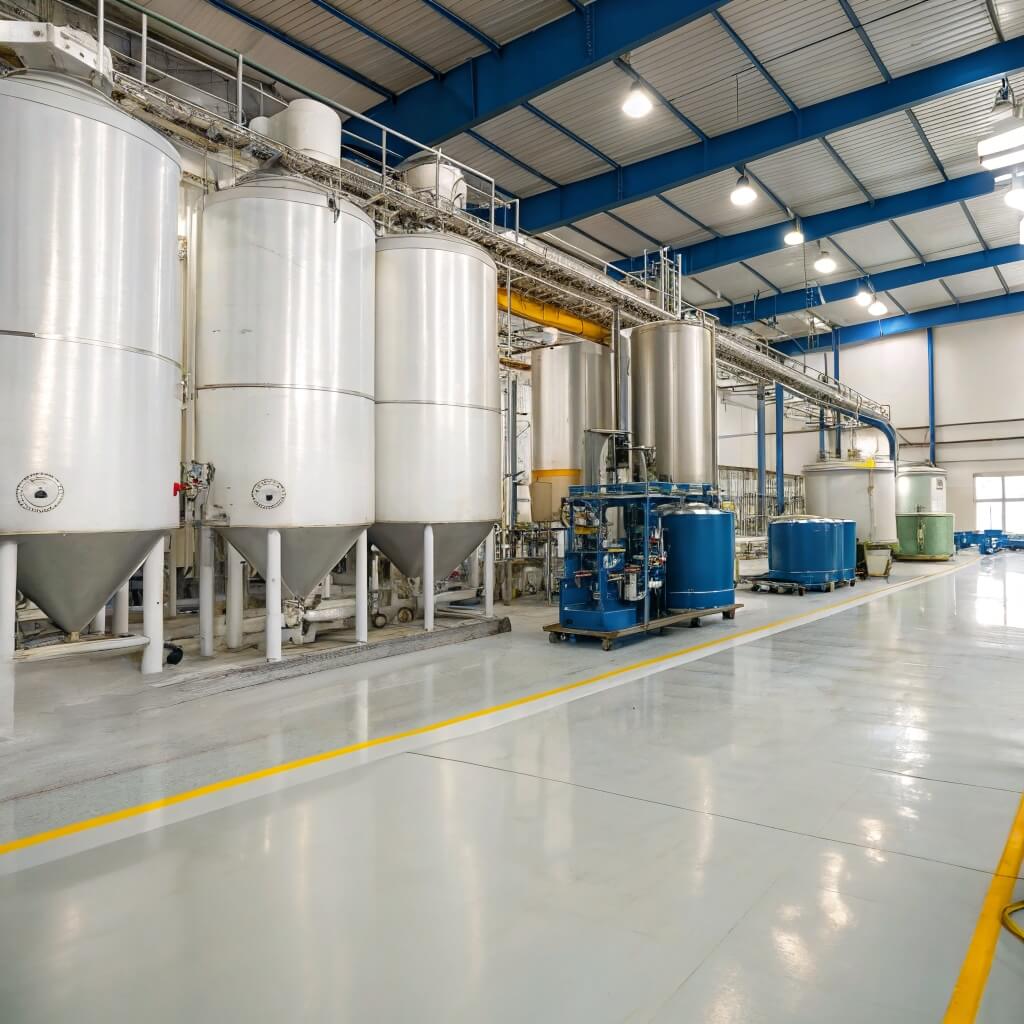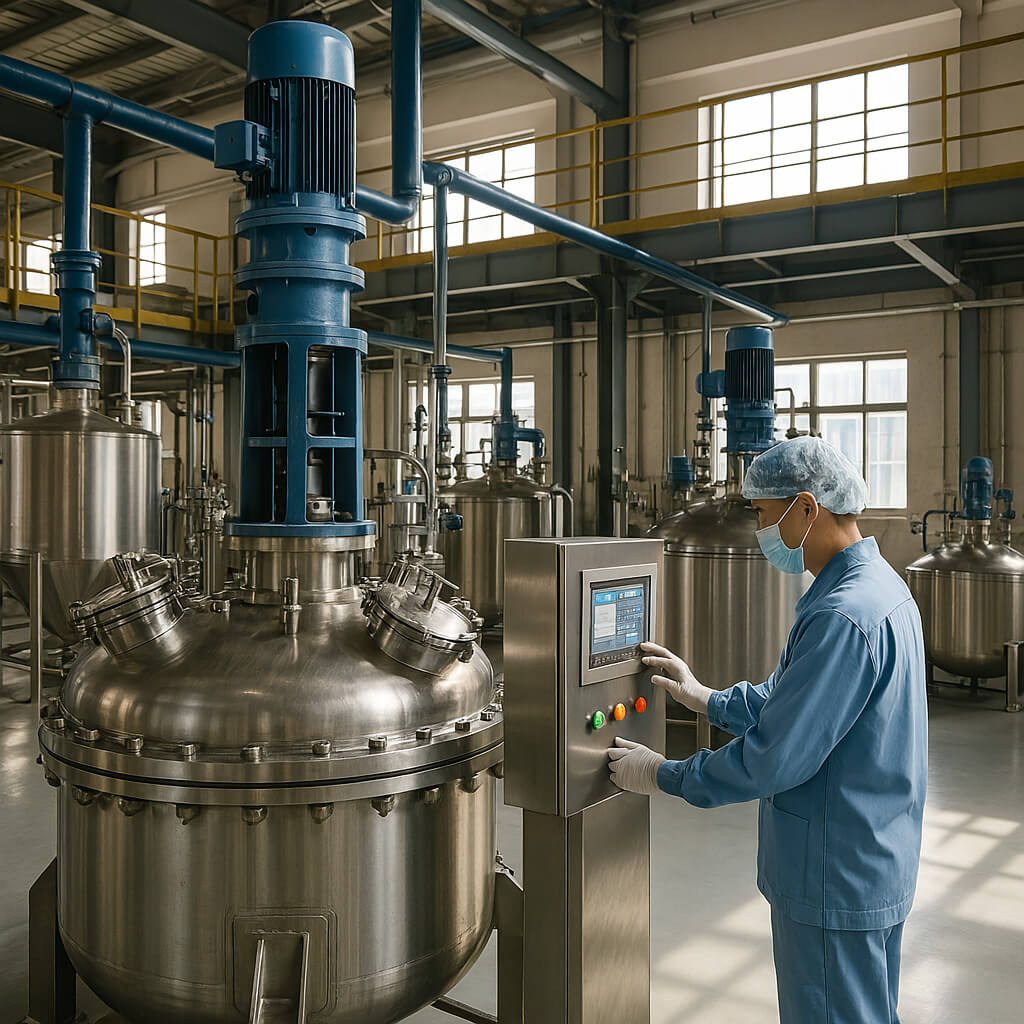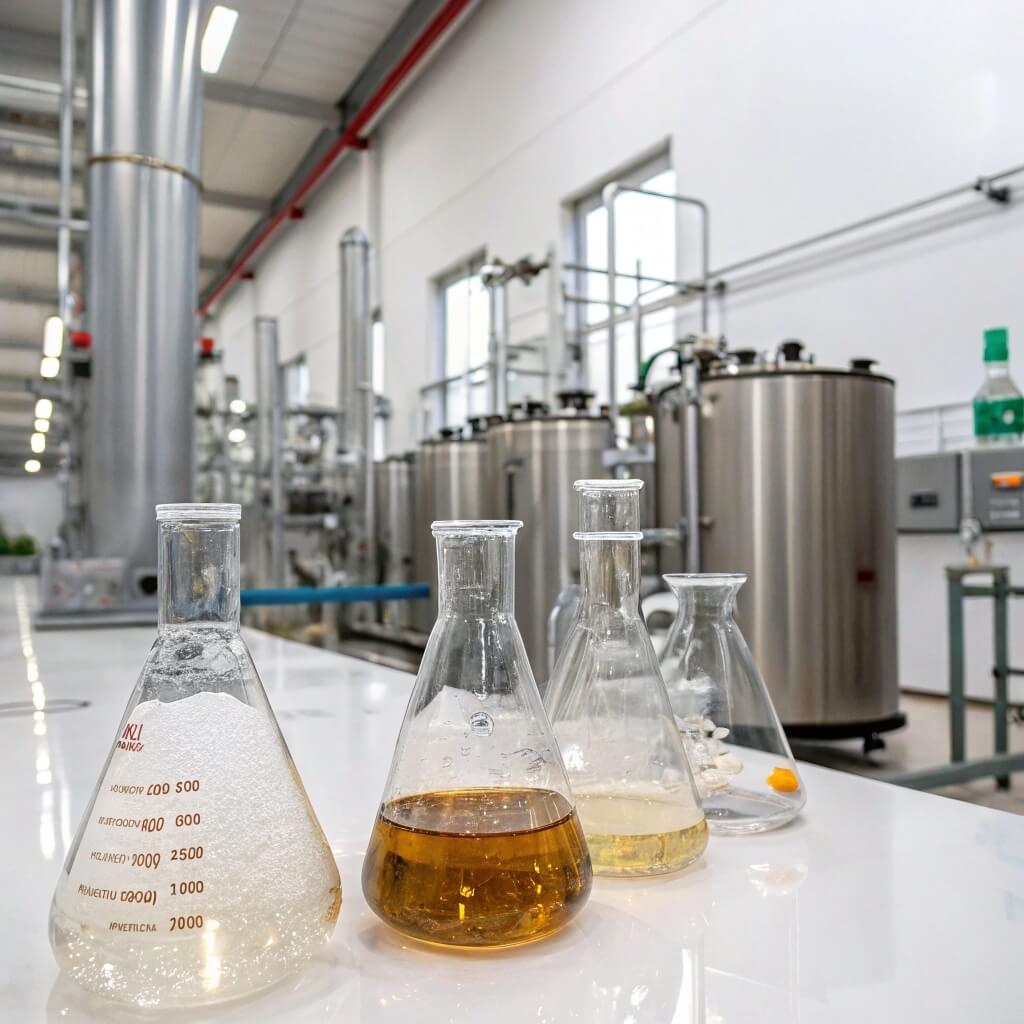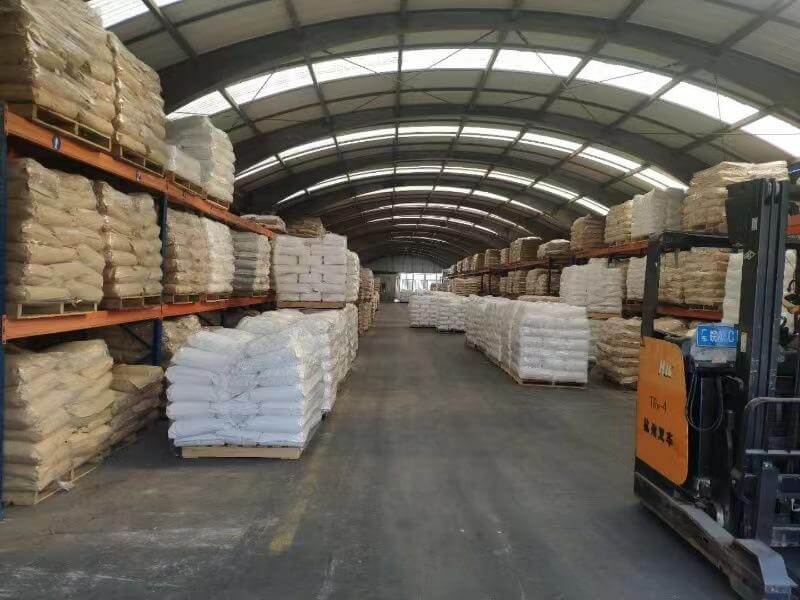Viscosity plays a crucial role in the performance of construction mortars, particularly those incorporating Hydroxypropyl Methylcellulose (HPMC). If the viscosity is inconsistent, it can affect workability, adhesion, and stability, potentially compromising the final product.
Viscosity is a key factor that determines the quality of construction materials such as dry mix mortars, tile adhesives, and other building products. This article explains the variables that influence HPMC viscosity and how to manage them for optimal results in construction applications.
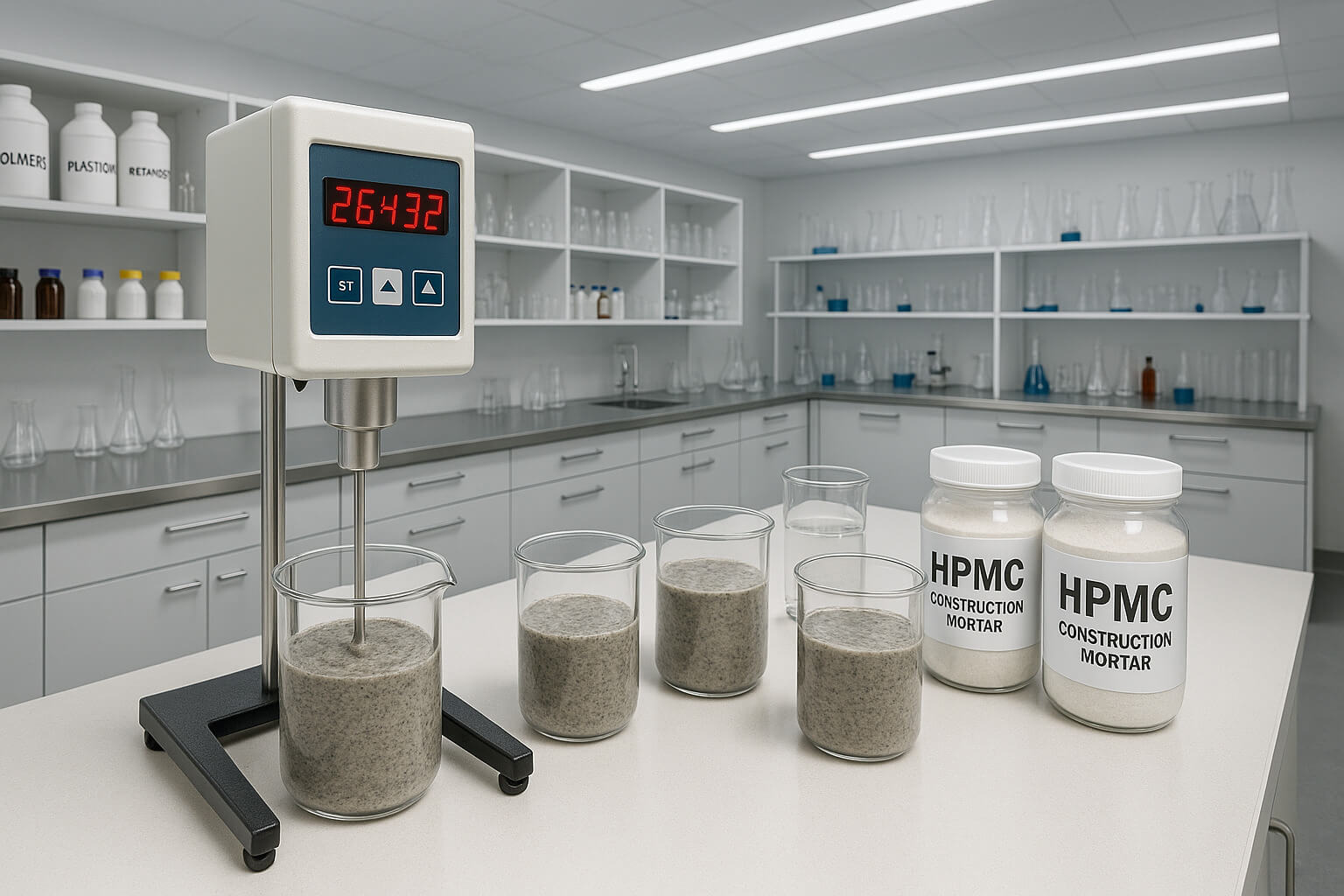
Image showing HPMC viscosity testing equipment and samples to illustrate measurement techniques.
In this article, we’ll explore the factors that influence HPMC viscosity, how temperature, shear rate, and concentration come into play, and the most effective methods for testing viscosity. We’ll also discuss how additives can stabilize viscosity and help in choosing the right grade of HPMC for specific mortar formulations.
Why Is HPMC Viscosity So Important for Construction Applications?
In construction, the viscosity of HPMC directly influences the handling and application of mortar, tile adhesive, and other products. Poor viscosity control can lead to issues like poor adhesion, inconsistent performance, or even product failure.
HPMC viscosity is crucial for achieving the right consistency in construction materials. Mortar and adhesives need the right balance of viscosity to ensure ease of application, stability, and overall product effectiveness.
HPMC is a cellulose ether used widely in construction for its water retention and thickening properties. It functions as a modificateur de rhéologie[^1], controlling the flow properties of the material. Viscosity affects not only the workability of the material but also the overall bonding strength and stability of the mortar.
[^1]: Learn about rheology modifiers to see how they influence material properties and improve construction processes.
Viscosity in construction materials needs to be carefully controlled for optimal performance. For example, in tile adhesives, high viscosity improves initial adhesion but too high viscosity can make the product difficult to spread. Conversely, low viscosity may reduce water retention and bond strength.
Temperature Effect on HPMC Viscosity
The viscosity of HPMC changes significantly with temperature. At higher temperatures, the viscosity tends to decrease, which can alter the workability and application of mortars. Mortar manufacturers must consider ambient temperature when formulating products to ensure consistency across different climates and environments.
| Temperature (°C) | Viscosity Effect |
|---|---|
| 20°C | Stable viscosity |
| 30°C | Decrease in viscosity |
| 40°C | Significant viscosity reduction |
Concentration Effect
Higher HPMC concentrations typically increase viscosity, as more polymer chains interact and resist flow. However, there is a balance to strike—too much concentration can lead to poor dispersion, while too little may not achieve the desired rheological properties.
| HPMC Concentration | Niveau de viscosité |
|---|---|
| 1% | Low viscosity |
| 2% | Moderate viscosity |
| 3% | High viscosity |
Viscosity levels in construction products must be tested under practical conditions to ensure the product performs as intended during both application and curing.
How Do Temperature, Shear Rate, and Concentration Impact HPMC Viscosity?
The key factors influencing HPMC viscosity are temperature, shear rate, and concentration. Let’s explore each factor in greater detail.
Understanding the role of temperature, shear rate, and concentration is essential for optimizing HPMC-based formulations. Each factor interacts differently, affecting the rheological properties of the material and its performance in real-world applications.
Temperature and Shear Rate Interaction
As temperature increases, viscosity generally decreases, making the material flow more easily. This is particularly important in regions with high temperatures, where mortar formulations need to maintain their properties despite changing conditions.
The shear rate also plays a role—higher shear rates, typically encountered during mixing or application, tend to decrease viscosity. This phenomenon is known as shear thinning. Mortars containing HPMC experience reduced viscosity under stress, making them easier to spread and apply.
| Facteur | Effet sur la viscosité |
|---|---|
| Température | Lower viscosity at higher temperatures |
| Shear Rate | Shear thinning effect, decreasing viscosity |
| Concentration | Higher concentration increases viscosity |
Shear Thinning Behavior in HPMC Mortars
HPMC est un pseudoplastic fluid, which means it exhibits shear thinning properties. As the shear rate increases, viscosity decreases, making the product easier to work with. This property is ideal for construction applications, where a balance between high viscosity for adhesion and low viscosity for application is required.
What Are the Most Accurate and Practical Methods for Testing HPMC Viscosity?
Accurate viscosity measurement is essential for controlling and optimizing HPMC in construction mortars. Different testing methods are used to determine viscosity, each offering unique advantages depending on the formulation and application.
Selecting the right viscosity testing method ensures the quality and consistency of HPMC-based products. Let’s take a closer look at some of the most commonly used techniques in the industry.
Le Brookfield Viscometer et Rotational Viscometer are two of the most reliable methods for measuring the viscosity of HPMC in construction products. These devices offer precise, repeatable measurements that allow manufacturers to ensure consistency in viscosity from batch to batch.
| Viscometer Type | Caractéristiques principales | Convient pour |
|---|---|---|
| Brookfield Viscometer | Measures viscosity at different shear rates | Viscosity of HPMC in thick mixtures |
| Rotational Viscometer | Provides continuous shear rate control | Mortar, tile adhesive testing |
Another commonly used tool is the Capillary Viscometer, which is often used for lower viscosity materials. This method measures the time taken for the liquid to pass through a small capillary tube under gravity, offering a simple yet effective way to determine viscosity.
Which Additives Can Modify or Stabilize HPMC Viscosity in Formulations?
Additives are often included in HPMC formulations to modify or stabilize viscosity. These substances can enhance the performance of construction materials, making them more adaptable to different environmental conditions and processing requirements.
Using the right additives can prevent viscosity degradation and ensure that the HPMC retains its performance over time. In some cases, additives can also improve properties like water retention, flowability, or resistance to shear.
Common Additives for Stabilizing HPMC Viscosity
- Électrolytes: Help stabilize viscosity by interacting with the polymer structure.
- Anti-microbial agents: Preserve viscosity by preventing microbial degradation in humid environments.
- Thickening agents: Such as starch derivatives, can help boost viscosity without altering other material properties.
| Type d'additif | Effet sur la viscosité |
|---|---|
| Électrolytes | Stabilizes viscosity |
| Anti-microbial agents | Preserves viscosity under humid conditions |
| Thickening agents | Increases viscosity without affecting other properties |
How to Select the Right HPMC Viscosity Grade for Different Mortar Systems?
Selecting the right viscosity grade of HPMC is crucial for the performance of different mortar systems. The viscosity grade determines how well the product will work in various applications, affecting everything from water retention to ease of application.
Choosing the correct HPMC viscosity grade ensures optimal performance in construction mortars. Let’s break down how to make the right selection based on specific requirements.
HPMC grades are categorized based on viscosity, and each grade has unique characteristics that make it suitable for different types of applications. For example, HPMC K100M is ideal for tile adhesives due to its high viscosity, while HPMC K15M is better for general-purpose mortars due to its lower viscosity.
| Qualité HPMC | Niveau de viscosité | Applications appropriées |
|---|---|---|
| HPMC K100M | High viscosity | Tile adhesive, dry mix mortar |
| HPMC K15M | Medium viscosity | General-purpose mortars |
FAQ on HPMC Viscosity for Industrial Buyers
What is the viscosity of hydroxypropyl methylcellulose?
The viscosity of HPMC depends on factors like concentration and molecular weight. Generally, higher concentrations and molecular weights lead to higher viscosity. For construction applications, viscosity levels are tailored to the specific needs of the mortar or adhesive, with typical ranges from 1,000 to 100,000 cPs.
Comment la température affecte-t-elle l’HPMC ?
Temperature significantly affects HPMC viscosity, with higher temperatures generally causing a reduction in viscosity. This behavior is important in ensuring that HPMC-based products maintain their desired consistency across different temperature environments.
What are the properties of hydroxypropyl methylcellulose HPMC?
HPMC is a water-soluble cellulose ether that provides water retention, thickening, and film-forming properties. It’s widely used in construction for its ability to improve mortar and adhesive properties by enhancing workability, adhesion, and stability.
Quelle est la viscosité du HPMC K100M et du HPMC K15M ?
HPMC K100M is a high-viscosity grade suitable for applications like tile adhesives, while HPMC K15M has a lower viscosity, ideal for general-purpose mortars. The viscosity of each grade varies depending on the specific formulation and required performance characteristics.
Conclusion
Understanding the factors affecting HPMC viscosity allows manufacturers to optimize their products for consistent performance in construction applications. By selecting the right grade and controlling factors like temperature and concentration, businesses can ensure the best results in their mortar formulations.

